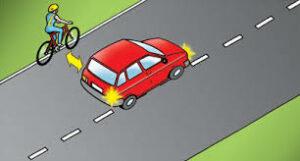Driving Lessons In North Dublin Road Position
When you are driving on your test, the one aspect of the test that the tester is constantly monitoring is your road position. Road position is where your car is positioned on the road as you drive. The tester is watching your position on the straight roads, left and right turns, roundabouts, coming up to traffic lights and when you are completing your manoeuvres. Today I will focus on road position on a straight road and also turning left. Always be mindful of your road position and constantly be aware of where you are positioned on the road. You will learn everything you need to know about road positioning in your EDT Lessons and always try to apply them for driving in the future.
Position on straight roads. When you are driving on straight roads, always be looking far down the road and look out for possible obstructions such as parked cars, road layout, roundabouts etc. If the way ahead is clear, keep your car positioned to the left-hand side of the road. Keep your car positioned about a door’s width away from the footpath. Be mindful of drains and if it is raining be mindful of puddles. Keeping into the left side of the road means you are keeping away from the centre line in the middle of the road. Driving too close to the centre line is dangerous as traffic coming from the opposite direction can be too close.

The red car in the diagram has a good road position as the car is positioned into the left safely.

When an obstruction presents itself, calmly check your mirrors and if you need to indicate to the right do so and overtake the obstruction, leaving plenty of room between your car and the obstruction. Only indicate if you have to change lanes to warn drivers behind and in front of you. If it is a slight steer of the steering wheel to avoid a drain or a puddle, there is no need to indicate. After you passed the obstruction, again, check your mirrors, if nobody is coming up on the left, signal left and gradually steer your car back into the left-hand side of the road.
Position on left and turns. When the tester gives you an instruction such as “at the T junction I would like you to go left.” This should automatically make you think about how you want to approach this left turn. Ask yourself is there a stop sign or a yield sign? Is there traffic up ahead? Is there a bicycle lane to the left? After the split second it takes to read the road ahead, check your mirrors. Check your inside mirror and then your left wing mirror to see if the way is clear. If the way is clear, signal your intention and gradually move the car in towards the left. As you are doing this, reduce your speed and select a lower gear. If you know that you have to stop ahead, always gradually brake and avoid coasting. Always check your mirrors and be aware of cyclists coming up the inside. When you get to the junction, always look right and left and always read the road ahead that you will be driving onto. When you do this you will know where to position your car on the new road. And always remember new road, new mirrors. Always be aware of what is in front of you and what could potentially be coming from behind you.
Holding your road position when you are driving shows the tester that you are a competent driver. If you hold your nerve with the position on your car the whole time and greatly enhances your chance of passing. Poor road position is one of the most common forms of failure on the driving test. Hold your position, you can do it.